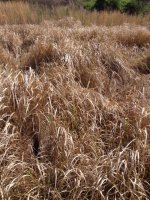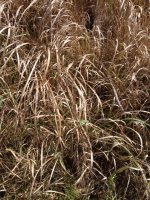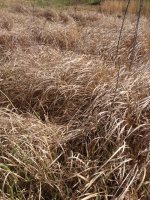Does it look like this grass when it's growing?
This grass is the kind you don't want in your yard | AL.com
COGONGRASS FACTS
IDENTIFICATION [of Jap, Cogongrass]
Cogongrass has some distinctive vegetative features that aid identification.� Cogongrass rarely is found as a single plant but quickly forms patches or infestations, often circular in outline.� Plants vary in height, even in the same patch from 1 to 4 ft. tall (1,5).� Taller leaves will lean over in late summer.� Leaves measure �-1 inch in width and are commonly 12-30 inches long.� They rarely have a lush green color; instead, they appear mostly yellowish green.� A reddening of the leaves sometimes has been observed in the fall, and is correlated to extreme changes in temperature.� The whitish upper midrib of a mature leaf is often not centered on the blade as with most grasses thus making identification somewhat easier. Also leaf margins are rough to the touch due to tiny saw-like serrations, which is a common trait of other grasses as well.� It is this rough margin, which may cut the tongue of a grazing animal, along with a high silica content that make cogongrass a useless forage crop.� The leaves appear to arise directly from the soil, giving the impression that the plant is stemless, but short stems are present.� A few short hairs may arise at the node, or the place where the leaf arises from the stem, but otherwise the plant is hairless.
Another key identifying feature is the production of fluffy, white, plume-like seedheads in early spring.� This spring flowering is contrary to most summer grasses, which flower later in the season.� Cogongrass also has been documented to initiate flowering at other times of the year in response to disturbance such as herbicide application, fire, mowing, or the first hard frost (4).� Seedheads range from 2 to 8 inches in length and may contain as many as 3000 seed.� Each seed has silky, white hairs that aid in wind dispersal.� Seed viability is variable and seed must land on bare ground for germination (3).� Rhizomes of cogongrass are white, segmented and branched and have been found extending 48 inches below the soil surface, but more commonly completely occupy the upper 6-8 inches (2,5).� Rhizomes are sharp-pointed and often pierce the roots of other plants and unprotected human feet and hands.� Each rhizome segment can give rise to a new plant, which can occur with cultivation or partial herbicide control (4).���



